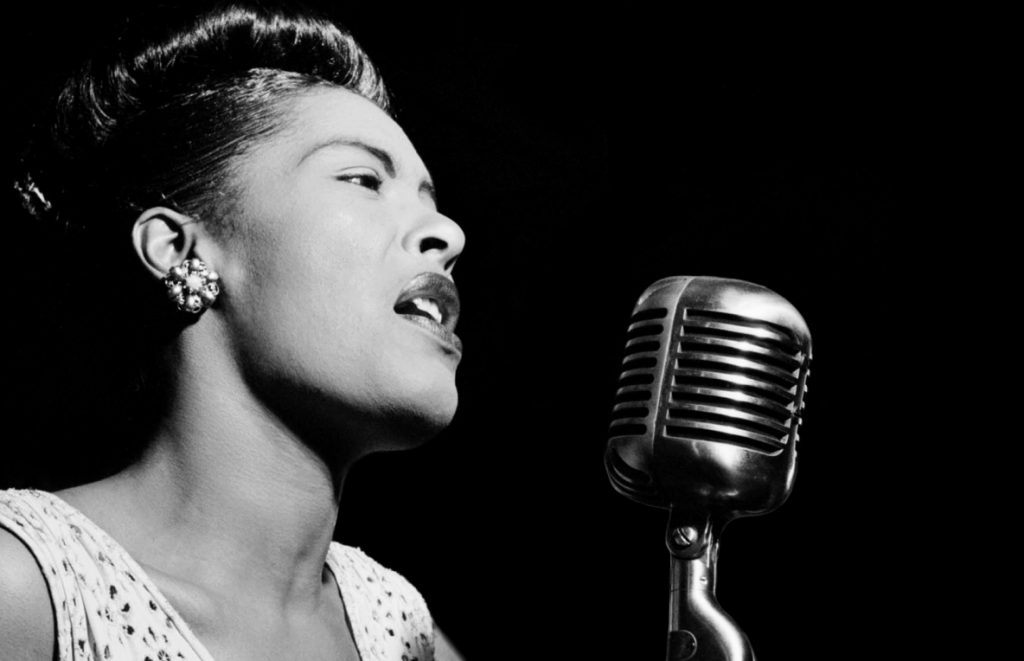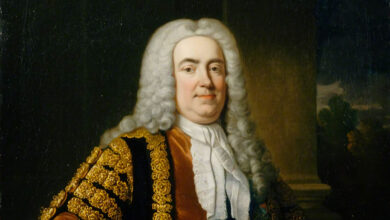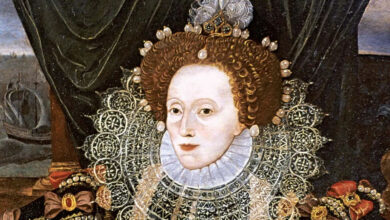
“I never had a chance to play with dolls like other kids. I started working when I was six years old.” – Billie Holiday
Podcast: Play in new window | Download
Subscribe: Spotify | Amazon Music | Youtube Music | RSS
Billie Holiday Biography
Billie Holiday was a well-known American jazz singer who was born on 7 April 1915 as Eleanora Fagan in Philadelphia, Pennsylvania. Her prolific singing career spanned almost thirty years and what she lacked in formal music education and range, she made up for with style. She was known for her improvisational skills creating different methods of tempo, vocal delivery and phrasing with jazz instrumentalists heavily inspiring her singing style.
Her parents were unmarried teenagers Sarah Julia Fagan who was known to everyone as Sadie and Clarence Holiday. Her mother Sarah was evicted from her parent’s home in Baltimore, Maryland after she became pregnant with Eleanora at the age of only nineteen.
Sarah moved to Pennsylvania, but Clarence decided to leave his family just after Eleanora was born to become a jazz banjo player. As Sarah’s parents also offered her no support, she sent Eleanora initially to live with her married half-sister in Baltimore.
Billie Holiday continued to have a difficult childhood and was raised by numerous people during the first decade of her life. Her mother worked in transportation jobs, mostly as a server for passenger trains and so Billie did not spend that much time with her. She was often absent from school and ended up in juvenile court in 1925 at the age of nine. After this, she went to a Catholic reform school called House of the Good Shepherd. Nine months later she was reunited with her mother who had opened a restaurant. They worked there together many long hours and by the age of eleven, Billie had completely dropped out of school.
When Billie Holiday was ten years old a neighbour had attempted to rape her, but he was arrested, and she returned to House of the Good Shepherd as a form of protective custody. At twelve years old she worked for a brothel running errands and she also scrubbed floors in the neighbourhood. At this time she also started listening to music and heard the records of Bessie Smith and Louis Armstrong.
In 1929 she went to live with her mother in Harlem, New York. Their landlady ran a brothel where Billie’s mother worked as a prostitute and it wasn’t long before mother and daughter were working together again with Billie becoming a prostitute herself at the age of only fourteen.
At around the same time, Billie Holiday started singing in nightclubs around Harlem. She took her father’s last name and the first name of Billie Dove, an actress she looked up to, and Billie Holiday was born. In 1932 she was singing at a club where she had replaced singer Monette Moore for the evening. Producer John Hammond had come to hear Moore sing but ended up hearing Holiday instead, a piece of good fortune that led to Billie making her recording debut at the age of eighteen. The song she recorded, ‘Riffin’ the Scotch’, sold an impressive 5,000 copies and Hammond said of Holiday, “Her singing almost changed my music tastes and my musical life because she was the first girl singer I’d come across who actually sang like an improvising jazz genius.” She was compared with the great Louis Armstrong, which was an incredible compliment for her.
Her career transitioned from singles and jazz clubs to mainstream success with Decca Records and Columbia Records and her song with Teddy Wilson, ‘What a Little Moonlight Can Do’, became a jazz standard.
At one point she was in competition with another popular singer at the time, Ella Fitzgerald, but they would later become good friends.
When working for Columbia in the 1930s Billie Holiday sang the song “Strange Fruit” based on a dark poem about lynching. The lyrics include the words, “Southern trees bear strange fruit, blood on the leaves and blood at the root. Black bodies swinging in the southern breeze. Strange fruit hanging from the poplar trees…” She was very hesitant to sing the song at first because she said that it reminded her of her father’s death. Holiday said that medical treatment was denied him because of racial prejudice when he had a fatal lung disorder. She said, “It reminds me how Pop died, but I have to keep singing it, not only because people ask for it, but because twenty years after Pop died the things that killed him are still happening in the South.”
The song helped to increase her popularity, and she started to achieve wider recognition with even Time Magazine referencing her. By the mid-1940s she had started to earn a considerable income and in 1947, she made $250,000 for the third year in a row. But her career was about to take a downward turn. On 16 May 1947, Billie Holiday was arrested in her home for narcotics possession and found herself in court. The court case was called the United States Versus Billie Holiday and she said that it felt exactly like that, with the whole world seemingly against her. Even her own lawyer refused to attend court and so she pleaded guilty. She served just less than a year in Alderson Federal Prison Camp in West Virginia.
Ed Fishman who had fought to take over as Billie Holiday’s manager from Joe Glaser had conjured up the idea of a comeback concert at Carnegie Hall. Eleven days after being released from prison, a reluctant Billie played to the sold-out venue. She also played on Broadway for three weeks in a show called Holiday on Broadway. It too was a smash hit, with all tickets selling out every night.
By the 1950s Billie Holiday’s addiction to drugs and alcohol and the abusive relationships she got into with men started to take a toll on her health and her later recordings reveal the damage being caused as her former vibrant voice was replaced with one that was coarser.
In 1954 she toured Europe taking in Sweden, Germany, The Netherlands, France and Switzerland with a live set in Germany being released as Lady Love – Billie Holiday.
In 1956 a ghost-written autobiography entitled Lady Sings the Blues and an album with the same title was released to accompany it. It featured new songs and eight re-recordings of her biggest hits to date including Strange Fruit and God Bless the Child.
Later in the same year, Billie Holiday performed again at Carnegie Hall and both dates sold out, with a live recording of the second one being released posthumously in 1961 entitled The Essential Billie Holiday.
By 1959 Billie had lost twenty pounds and had been diagnosed with cirrhosis. She initially stopped drinking as a result but it wasn’t long before she started again. All of her friends and her manager tried to get her to go to the hospital but she refused. However, on 31 May 1959, she was taken to hospital in New York for treatment for liver disease. Even as she lay dying in her hospital room she was arrested for narcotics possession, handcuffed and placed under a police guard.
Fifteen days later Billie Holiday received the last rights and died at ten past three in the morning on 17 July 1959. The cause of death was pulmonary oedema and heart failure brought on by cirrhosis of the liver. She was forty-four years old.
Most of Billie Holiday’s music appears on albums recorded for four record labels. Columbia Records, Commodore Records, Decca Records and Verve Records. She is still regarded as one of the best female jazz singers of all time. Two years after her death, she was inducted into the Down Beat Hall of Fame and consequently, Columbia re-released almost 100 of her early records leading to her posthumously winning 23 Grammy Awards.
She has since been inducted into the Grammy Hall of Fame, the Ertegun Jazz Hall of Fame and the Rock and Roll Hall of Fame.
In 2019 Chirlane McCray, the wife of New York City Mayor Bill de Blasio announced that New York City would honour Billie Holiday with a statue which would be built near Queens Borough Hall.
Podcast: Play in new window | Download
Subscribe: Spotify | Amazon Music | Youtube Music | RSS




